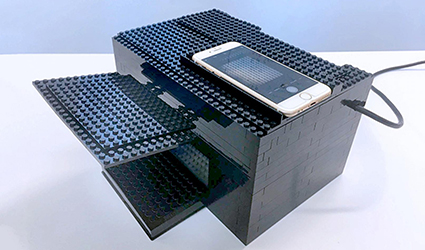New Device made of Lego & Smartphone to Detect Nerve Agents
June 29, 2018
Source: ScienceDaily
 783
783

Scientists from the University of Texas have developed a way to sense dangerous chemicals, a basic model consisting of a smartphone and a box made from Lego bricks, which could help scientists to identify deadly and difficult-to-detect nerve agents such as sarin and VX. The new approach combines a chemical sensor with photography to notice and recognize different nerve agents.
Eric Anslyn, a chemistry professor at the University of Texas, has been doing research for the past 20 years on nerve agents, using safe chemical compounds that act in the same way as nerve agents and can imitate them in testing. He earlier advanced chemical compounds that counterbalance nerve agents and at the same time generate a glow bright enough to be seen with the naked eye.
Anslyn said, "Chemical weapons are life taking threats to humanity, Detection and neutralization is the key to saving lives."
To make Anslyn's initial compound more convenient in a real-world scene, the new equipment uses affordable, accessible materials. The chemical sensors for the device is made in Anslyn’s lab by Xiaolong Sun and generates fluorescence, which is the main result of the analysis.
Sun said "It is difficult to see differences in the level of fluorescence with the naked eye. And instruments used in the lab to measure fluorescence cost $30,000 and are not portable; this device essentially takes photographs of the glowing."
The research team used an iPhone in the lab for the experiment since a camera on a smartphone is sensitive enough to detect the differences in shades and brightness in the glowing reaction. Software developed by graduate student Alexander Boulgakov identifies the type and concentration of the nerve agent.
However, the researchers also needed a pitch dark space to get a good reading on the camera which was when Pedro Metola, a clinical assistant professor at UT, thought of using Legos since it is cost effective and easily accessible.
Only an ultraviolet light is also required and standard 96-well test plate. The solution is inexpensive, portable making it ideal to use.
By DduRead more on
- Things to Know before Buying Newborn Baby Incubators March 31, 2022
- Highly Resistant Food Poisoning Bug Responds to Antibiotics September 6, 2018
- Smartphone Based Diagnosis to Identify Mosquitoes Transmitting Infection September 5, 2018
- 3 Natural Plant Extracts Manufacturers on Drugdu.com September 4, 2018
- Shenzhen Chuanggan – Health Assessment Facility Supplier September 4, 2018
your submission has already been received.
OK
Subscribe
Please enter a valid Email address!
Submit
The most relevant industry news & insight will be sent to you every two weeks.



